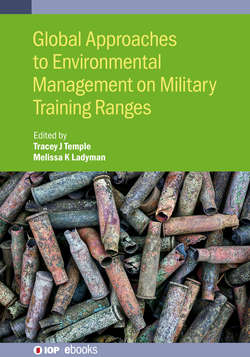Читать книгу Global Approaches to Environmental Management on Military Training Ranges - Tracey Temple - Страница 32
На сайте Литреса книга снята с продажи.
2.2 Background
ОглавлениеThe multi-increment sampling (MIS) method was adapted by scientists from the US Army Cold Regions Research and Engineering Laboratory (CRREL) to overcome the problem of data irreproducibility during field investigations carried out for the US Army Alaska at the Eagle River Flats (ERF) indirect-fire impact area on Fort Richardson, AK, USA [4]. Ducks dabbling in the estuarine salt marsh within which ERF is located were dying by the thousands with no apparent external injuries. Examination of tissues and gizzard contents from dead ducks, swans and shorebirds recovered from the impact area pointed to the ingestion of white phosphorus (WP, P4), a man-made form of elemental phosphorus used as an obscurant by artillery units during live-fire training [2]. Discrete (grab) sampling of the sediments in which the waterfowl were dabbling resulted in widely varying results, making quantification of the P4 and delineation of contaminated areas extremely difficult. Further investigation of the post-detonation characteristics of the contaminant indicated that the P4 was composed of small, discrete particles that were heterogeneously distributed near impact points throughout the permanently wet areas of the flats [5]. Discrete sampling, the common field sampling method for soils in use at the time, was an unreliable and inefficient method for finding and characterizing the areas of contamination within the impact area.
There was one method for finding P4 that appeared grimly efficient: the multiple-location dabbling for food that was conducted by the ducks. By ‘sampling’ many locations within a contaminated area, the ducks were finding (and ingesting) P4 particles and dying. The dabbling activity of the ducks was roughly imitated by field researchers by sampling along transects that were established in areas of high waterfowl mortality. Increments within the transects were taken at grid points based on the diameter of the crater formed by the detonation of an 81-mm WP round. Much more reliable data was possible using the transects, but some of the contaminated areas were quite large and a better characterization method was needed [2].
Similar data reproducibility issues were occurring with CRREL’s investigations of munitions residues on ranges [6]. In the late 1990s, CRREL researchers involved in the ERF project and munitions residues research program attended a short course on sampling given by Chuck Ramsey of Envirostat, Inc. The course described a method of sampling similar to that used by the agricultural and mining industries to characterize soils in delineated areas for the presence of elements such as nitrogen, phosphorus, copper and iron. The method is based on the theory of sampling developed by Pierre Guy and included the collection of many increments within a defined area to build a sample that will represent the environment from which it was obtained [7]. The course covered sources of error, defining those errors and describing in general terms how to improve data quality.
Following the sampling course, CRREL started a long-term collaborative effort with Envirostat to develop a comprehensive method of soil sampling that encompasses not only the collection of samples but how to set up a sampling plan, tools for sampling that will reduce sampling error while increasing efficiency, comminution of samples, the splitting of samples, and subsampling. All aspects of the process have been analyzed scientifically through a comprehensive research program on energetics residues on military training ranges. The methods developed at the laboratory and through field research have been and are presently being successfully applied to real-world characterization projects in the US, Canada and in several countries in Europe [8]. Sampling methods that incorporate multiple small increments in each sample have also been adapted to the sampling of energetics’ residues on snow surfaces, which has been invaluable in research characterizing munitions residues, in one case saving billions of dollars in potential environmental liabilities [9–11].
This chapter will walk the reader through methods needed for obtaining data that will enable the derivation of a reproducible mean analyte concentration within a designated area. We will start with the theory of sampling, upon which the Multi-Increment® environmental sampling method is based. We will then cover the types and sources of error inherent in soil sampling, methods of error reduction and quantification, how to obtain a representative sample, how to obtain a representative subsample and the current methods of analyzing for energetics. A subsequent chapter in this book presents a number of case studies for various types of training ranges that will give the reader a feel for how MIS is applied to real-world situations.
The methods and methodology described in this chapter must be implemented in full to obtain reproducible data [12]. The authors have conducted extensive research into methods that were and are commonly used, and almost all of these methods do not result in reproducible data. Omitting one of the steps would be like leaving a wheel off an automobile: You can do it and maybe still get to where you want to go, but the results will be catastrophic. Even modifying one of the steps could result in bad data. Think of having all four wheels but modifying the tire pressure at one of the wheels by deflating the tire.
